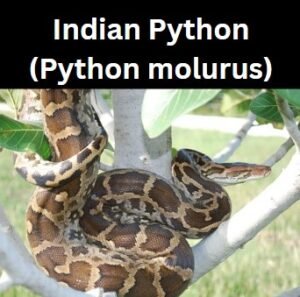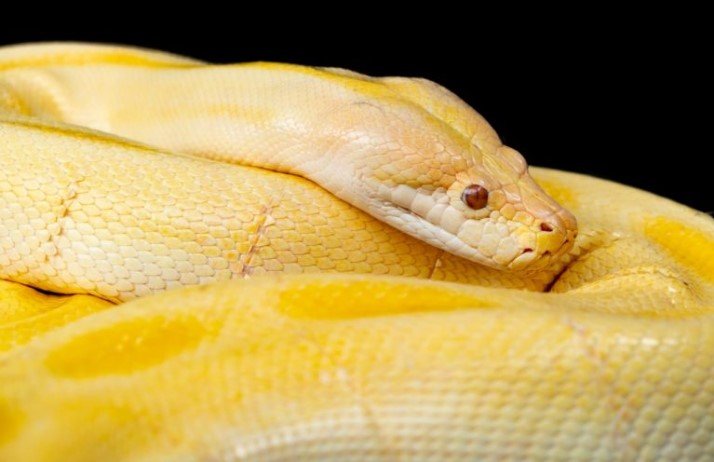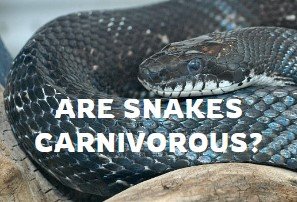Introduction
In the diverse landscapes of the Indian subcontinent, the Indian Python (Python molurus) glides with majestic grace, embodying the rich biodiversity of the region. This iconic serpent, known for its impressive size, unique behaviors, and vital ecological role, stands as a symbol of the intricate balance in the Indian wilderness. Join us on a journey to unravel the characteristics and behaviors that make the Indian Python a creature of wonder and awe.

Overview of the Indian Python
Taxonomy and Scientific Classification
The Indian Python, scientifically known as Python molurus, belongs to the family Pythonidae. Within this family, it is renowned for its substantial build and distinct patterns, reflecting its evolutionary adaptations.
Physical Characteristics and Color Variations
Characterized by a robust body and intricate patterns, the Indian Python exhibits a range of color variations, including earthy tones of brown, tan, and yellow. The distinctive patterns add to the snake’s allure, making it a captivating subject of study and admiration.
Geographic Distribution and Preferred Habitats
Endemic to the Indian subcontinent, the Indian Python thrives in diverse habitats, from dense forests and grasslands to marshes and swamps. Its adaptability to varied environments underscores its significance as a key player in maintaining the ecological balance of these ecosystems.
Size and Comparison with Other Serpents
Impressive Size and Characteristics
The Indian Python stands as one of the larger snake species globally, with individuals reaching lengths exceeding 15 feet and, in exceptional cases, approaching 20 feet. Its muscular build and striking appearance contribute to its commanding presence in its natural habitat.
Comparison with Other Python Species
In comparison to other python species, the Indian Python holds its own, showcasing a balance of size, strength, and adaptability. While not the largest python, it commands respect and fascination for its significant role in the ecosystems it inhabits.
Significance of Its Size in the Ecosystem
The size of the Indian Python is pivotal to its ecological role as an apex predator. Its ability to control prey populations, particularly small mammals and birds, contributes to the overall health and balance of the ecosystems within its range.
Life Cycle and Reproduction
Reproductive Biology and Mating Rituals
The life cycle of the Indian Python is a marvel of nature, involving intricate mating rituals. Female pythons exhibit discerning mate selection, contributing to the genetic diversity and resilience of the species.
Nesting Behaviors and Maternal Care
Nesting behaviors of female Indian Pythons involve selecting suitable locations and coiling around the eggs to provide protection and regulate temperature. Maternal care extends to the post-hatching period, where hatchlings receive guidance and warmth from their mother.
Growth and Development of Python Hatchlings
The growth and development of Indian Python hatchlings are rapid, driven by a diet of small mammals and birds. Understanding this crucial phase provides insights into the species’ resilience and adaptability.
Constricting Abilities and Feeding Behaviors
Mechanism of Constriction and Subduing Prey
The Indian Python employs a powerful constriction mechanism to subdue its prey. By coiling around the victim and applying pressure, the python immobilizes and ultimately overpowers its prey, showcasing an elegant and effective hunting strategy.
Varied Diet and Hunting Strategies
Indian Pythons have a diverse diet, encompassing small to medium-sized mammals, birds, and occasionally larger prey. Their hunting strategies involve both ambush techniques and active searching, making them versatile predators within their ecosystems.
Role in Maintaining Ecological Balance
As apex predators, Indian Pythons play a crucial role in regulating prey populations, contributing to the overall health and balance of the ecosystems they inhabit. Their impact on smaller mammals and birds helps maintain biodiversity and prevent overpopulation of certain species.
Human Perspectives and Conservation
Human Interactions and Perceptions
Interactions between humans and Indian Pythons are diverse, influenced by cultural perspectives and occasional conflicts. While revered in some cultures, these pythons are sometimes viewed with fear due to their size. Responsible coexistence involves understanding their behaviors and implementing measures to mitigate potential conflicts.
Conservation Status and Threats
Indian Pythons face threats to their populations, including habitat loss, illegal pet trade, and potential persecution. Understanding these threats is crucial for formulating effective conservation strategies to protect this iconic species and the ecosystems it inhabits.
Conservation Efforts and Responsible Coexistence
Conservation initiatives focus on preserving the habitats of Indian Pythons, raising awareness about their ecological importance, and promoting responsible coexistence with local communities. By integrating local knowledge and cultural perspectives, conservation efforts can be more effective in safeguarding the future of these magnificent snakes.
Conclusion
Recap of the Indian Python’s Characteristics and Behaviors
In concluding our exploration of the Indian Python, we reflect on its impressive characteristics and behaviors. From its imposing size to its role as a key predator, the Indian Python stands as a testament to the wonders of the Indian subcontinent’s biodiversity.
The Delicate Balance Between Fascination and Conservation
The Indian Python inspires fascination and awe, yet its conservation requires a delicate balance between human appreciation and responsible stewardship. By fostering understanding and respect, we can contribute to the preservation of this magnificent species and the ecosystems it calls home.
A Call to Appreciation and Responsible Stewardship
As stewards of our planet, it is our responsibility to appreciate the natural world and the incredible creatures that inhabit it. Let us extend our appreciation to the Indian Python, recognizing its vital role in maintaining the balance of ecosystems, and work collectively to ensure its conservation for generations to come.
Learn more about Python.





Leave a Reply